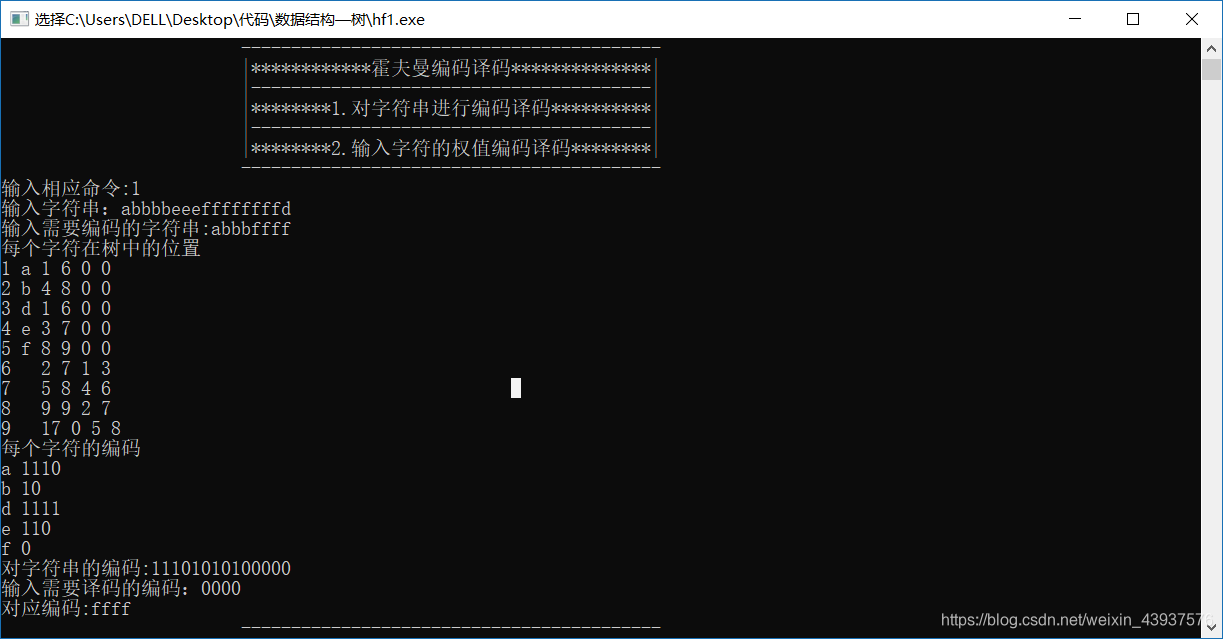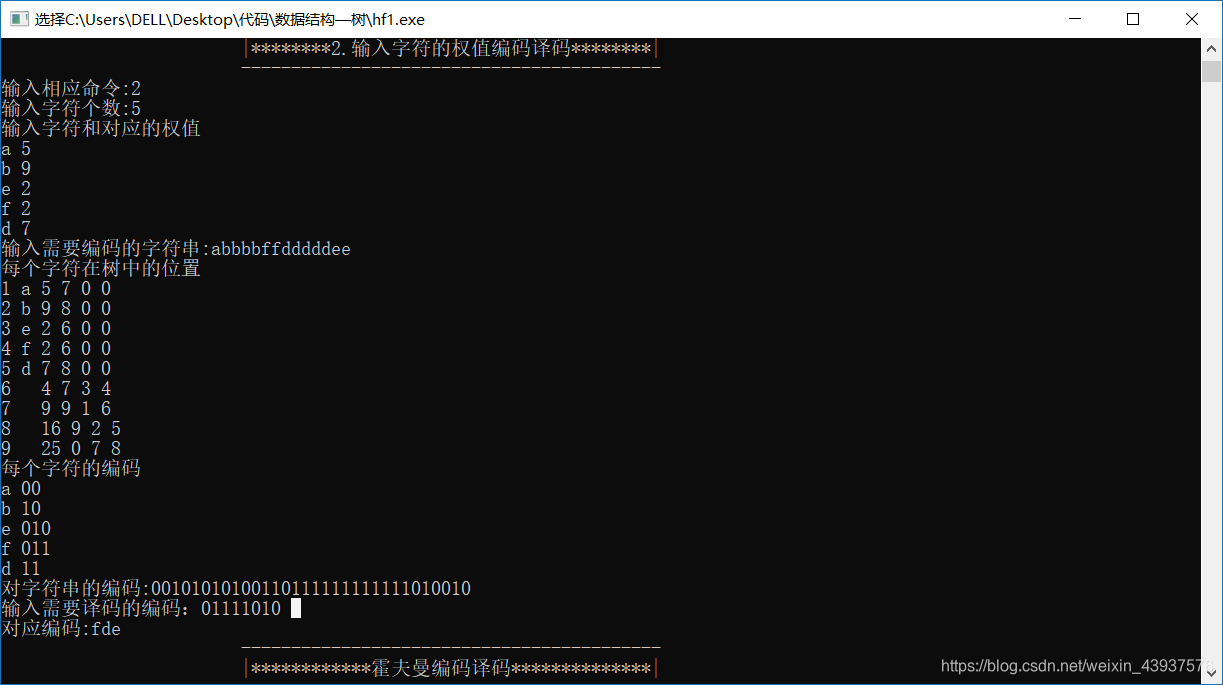#include<iostream>
#include<stdlib.h>
#include<cstring>
using namespace std;
typedef struct hftree{
int might;
int parent,lch,rch;
char data;
}*tree,node;
typedef char** treecode;
int length;//字符串长度;
void chushi(tree &hf,int n)//初始话
{
hf=new node[2*n];
for(int i=1;i<=2*n-1;i++)
{
hf[i].data='\0';
hf[i].might=0;
hf[i].lch=0;
hf[i].rch=0;
hf[i].parent=0;
}
}
void select(tree T,int n,int &s1,int &s2)//找出权值最小的两个;
{
int k,m;
k=m=1000000;
for(int j=1;j<=n;j++)
{
if(m>T[j].might&&T[j].parent==0)
{
m=T[j].might;
s1=j;
}
}
for(int i=1;i<=n;i++)
{
if(i!=s1&&k>T[i].might&&T[i].parent==0)
{
k=T[i].might;
s2=i;
}
}
}
void hftree(tree &hf,int n)//创建霍夫曼树
{
int s1,s2;
if(n<=1) return;
int m=2*n-1;
for(int i=n+1;i<=m;++i)
{
select(hf,i-1,s1,s2);
hf[s1].parent=i;
hf[s2].parent=i;
if(s1<=s2){
hf[i].lch=s1;
hf[i].rch=s2;
}
else{
hf[i].lch=s2;
hf[i].rch=s1;
}
hf[i].might=hf[s1].might+hf[s2].might;
}
}
void codetree(tree hf,treecode &hc,int n)//获取字符的编码值
{
int m,p;
hc=new char*[n+1]; //指针数组;
char *cd=new char[n]; //存放编码
cd[n-1]='\0';
for(int i=1;i<=n;i++)
{
int start=n-1;
m=i;
p=hf[i].parent;
while(p!=0)
{
--start;
if(hf[p].lch==m)
{
cd[start]='0';
}
else
cd[start]='1';
m=p;
p=hf[p].parent;
}
hc[i]=new char[n-start];
strcpy(hc[i],&cd[start]);
}
delete []cd;
}
void input(tree &hf,int &n,char *date)//输入字符串
{
char *a=date;
int length_1;
int num[256]={0};
int b[256];
int c[256];
cout<<"输入字符串:";
getchar();
gets(a);
length_1=strlen(a);
for(int i=0;i<length_1;i++)
{
num[(int)a[i]]++;//统计每个字符的权值
}
n=0;
for(int i=0;i<256;i++)
{
if(num[i]!=0)
{
b[n]=num[i];
c[n]=(char)i;
++n;
}
}
hf=new node[2*n];
for(int i=1;i<=2*n-1;i++)
{
hf[i].data='\0';
hf[i].might=0;
hf[i].lch=0;
hf[i].rch=0;
hf[i].parent=0;
}
for(int i=1;i<=n;i++)
{
hf[i].might=b[i-1];
hf[i].data=c[i-1];
}
}
int weizhi(tree hf,char *q,int n) //获取字符在树中的位置
{
char *date=q;
for(int j=1;j<=n;++j)
{
if(*date==hf[j].data)
return j;
}
}
void bianmachar(tree hf,char *q,treecode &result,int n)//对字符串编码
{
char *date=q;
char *cd;
int m,p;
result=new char * [length+1];//存放每个字符的编码值;
cd=new char[n];
cd[n-1]='\0';
for(int i=0;i<length;++i)
{
m=weizhi(hf,&date[i],n);//获取每个字符在树中的位置
int start=n-1;
p=hf[m].parent;
while(p!=0)
{
--start;
if(hf[p].lch==m)
{
cd[start]='0';
}
else
cd[start]='1';
m=p;
p=hf[p].parent;
}
result[i+1]=new char[n-start];
strcpy(result[i+1],&cd[start]);
}
delete cd;
}
void chu(tree hf,treecode hc,treecode result,int n)//输出编码
{
int m=2*n-1;
cout<<"每个字符在树中的位置"<<endl;
for(int i=1;i<=m;i++)
{
cout<<i<<" "<<hf[i].data<<" "<<hf[i].might<<" "<<hf[i].parent<<" "<<hf[i].lch<<" "<<hf[i].rch<<endl;
}
cout<<"每个字符的编码"<<endl;
for(int i=1;i<=n;i++)
{
cout<<hf[i].data<<" "<<hc[i]<<endl;
}
cout<<"对字符串的编码:";
for(int j=1;j<=length;j++)
{
cout<<result[j];
}
}
void input_(tree &hf,int &n) //输入每个字符和对应的权值
{
cout<<"输入字符和对应的权值"<<endl;
for(int i=1;i<=n;i++)
{
cin>>hf[i].data;
cin>>hf[i].might;
}
}
void Decodehf(tree hf,char *m,int n)//译码
{
char*date=m;//编码字符串
int LL=strlen(date);//编码字符串长度
char data[100];//解码字符串;
int p=2*n-1;//获取根节点的位置;
int j=0;//头指针
for(int i=0;i<length;i++)
{
if(date[i]=='0')
p=hf[p].lch;
else if(date[i]=='1')
p=hf[p].rch;
if(hf[p].lch==0&&hf[p].rch==0)
{
data[j]=hf[p].data;
p=2*n-1;
++j;
}
}
cout<<"对应编码:";
for(int k=0;k<j;k++)
{
cout<<data[k];
}
cout<<endl;
}
void Xmb()//界面
{ cout<<"\t\t\t------------------------------------------"<<endl;
cout<<"\t\t\t|************霍夫曼编码译码**************|"<<endl;
cout<<"\t\t\t|----------------------------------------|"<<endl;
cout<<"\t\t\t|********1.对字符串进行编码译码**********|"<<endl;
cout<<"\t\t\t|----------------------------------------|"<<endl;
cout<<"\t\t\t|********2.输入字符的权值编码译码********|"<<endl;
cout<<"\t\t\t------------------------------------------"<<endl;
}
int main()
{
char a;
char date_1[100];//输入字符串统计权值
char date_2[100];//需要要编码的字符串
char date_3[100];//存储译码的字符串
tree hf; //hfm树
treecode hc;//存储每个字符的译码
treecode result;//存放译码的字符串
int n;//拥有权值的字符个数
while(1)
{
Xmb();
cout<<"输入相应命令:";
cin>>a;
switch(a)
{
case '1':
input(hf,n,date_1);
hftree(hf,n);//创建霍夫曼树
codetree(hf,hc,n);//每个字符的编码
cout<<"输入需要编码的字符串:";
gets(date_2);
length=strlen(date_2);
bianmachar(hf,date_2,result,n);//字符串的编码
chu(hf,hc,result,n);
cout<<endl;
cout<<"输入需要译码的编码:" ;
gets(date_3);
Decodehf(hf,date_3,n);
break;
case '2':
cout<<"输入字符个数:";
cin>>n;
chushi(hf,n);//对霍夫曼树初始化
input_(hf,n);//输入字符和对应的权值
hftree(hf,n);
codetree(hf,hc,n);
cout<<"输入需要编码的字符串:";
getchar();
gets(date_2);
length=strlen(date_2);
bianmachar(hf,date_2,result,n);
chu(hf,hc,result,n);
cout<<endl;
cout<<"输入需要译码的编码:" ;
gets(date_3);
Decodehf(hf,date_3,n);
break;
case '0':
exit(0);
}
}
}






 博客围绕霍夫曼树展开,虽未给出具体内容,但可知核心为霍夫曼树,它是信息技术领域算法范畴的重要概念。
博客围绕霍夫曼树展开,虽未给出具体内容,但可知核心为霍夫曼树,它是信息技术领域算法范畴的重要概念。
















 903
903

 被折叠的 条评论
为什么被折叠?
被折叠的 条评论
为什么被折叠?








